
Sensors are an vital part of any smart home. They can be used to detect intrusions, to tell when it’s getting dark, and to establish the temperature, among many other things.
Sensors are, as the name suggests, devices designed to ‘sense’ changes in the environment in and around your home. Sensors can be used to detect changes in temperature, light levels, motion and weight, among other things. Using the signals sent back from sensors, your home automation system can decide what sort of functions need to be activated, and when.
What types of sensors are used in home automation?
There are many different types of sensors used in home automation. Below is a list describing some of the more commonly used varieties.
- Light level sensors – These sensors evaluate the amount of light available.
- Motion sensors – Also known as occupancy sensors, these sensors detect movement.
- Temperature sensors – These sensors detect the temperature in a given area or on a surface.
- Smoke sensors – Most often found in smoke alarms, these sensors detect smoke in the air.
- Carbon Monoxide sensors – These sensors detect high levels of deadly carbon monoxide.
- Contact sensors – These sensors are used to indicate when a door or window is opened or closed.
- Glass-break sensors – These sensors use a microphone to detect strong vibrations on windows.
- Humidity sensors – Also known as hygrometers, humidity sensors measure the humidity in the air.
- Stress sensors – These are installed under floors or driveways to detect when an area is being used.
How are sensors used for home automation?
Sensors can be used in many different ways, and for many different purposes, but are normally employed to improve comfort, security or energy efficiency.
Lighting automation
Light level, motion and temperature sensors can all be used to automate lighting in your home. Lights can be turned on or off when people enter or exit a room using motion sensors, and light level and temperature sensors can be used to make sure that blinds and curtains make the most of available daylight, and provide privacy when the sun goes down.
Climate control
Temperature and humidity sensors contribute to maintaining the climate in your house. Temperature sensors act to determine the temperature both inside and outside of your home, and can be used to control your heating, cooling or ventilation systems accordingly. They can also be used to determine when windows and blinds should be opened and closed for the purpose of climate control.
Humidity sensors provide a reading of the humidity in the air, which can be used for the purpose of regulating your ventilation. Some bathroom exhaust fans are automatically activated using built-in humidity sensors.
Security and safety
Motion, contact, glass-break and stress sensors are useful devices for security in your home, while smoke and carbon-monoxide sensors will ensure your family’s safety against dangerous gases. Motion and contact sensors can be used in alarm systems to ensure all doors or windows are properly sealed, while glass-break and stress sensors can be used to alert you if there are intruders in your home. Stress sensors can also be programmed to directly contact emergency services, or can even be installed under a driveway to automatically turn things on when you get home.
Smoke and carbon-monoxide sensors will alert you to increased amounts of smoke or carbon-monoxide in your home. If they’re installed in different parts of the house, the alarm from one sensor can allow you to understand exactly where the danger is coming from and how best to avoid that area. Changing the batteries in your smoke alarm when daylight savings time changes is a good way to ensure your batteries are always fresh.
What variations exist?
There are many types of sensors available, and each may have varying functions and degrees of sensitivity. For a better idea of what’s available and suitable for your needs, talk to a qualified installer.





